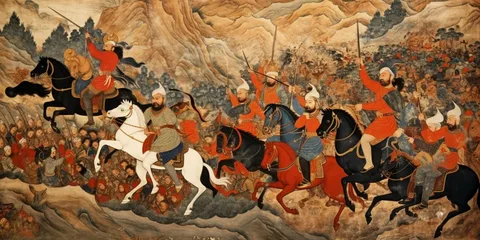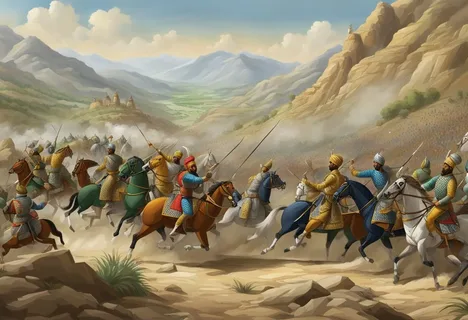The Battle of Bani Qurayzah, fought in 5 Hijri (627 CE), was a significant and final conflict involving the Jewish tribe of Bani Qurayzah in Medina during the time of the Prophet Muhammad. This battle followed the pivotal Battle of the Trench and was triggered by the tribe’s betrayal of their treaty with the Muslims by allying with the polytheists during the siege of Medina.
The battle of Bani Qurayzah
The Bani Qurayzah were one of the Jewish tribes living in Medina with a treaty of alliance with the Muslim community led by Prophet Muhammad. During the Battle of the Trench in 627 CE, the polytheist Meccans and their allies besieged Medina, and the Muslims defended themselves by digging a trench around the city. However, the Bani Qurayzah violated their treaty by conspiring with the Meccans to attack the Muslims from the inside. Reports indicate that they refused to aid the Muslims in the defense and instead plotted with the enemy, undermining the Muslim defensive efforts.
When the Muslims learned of Bani Qurayzah’s betrayal, the Prophet Muhammad dispatched an armed force to besiege their stronghold. The tribe had a strategic position that could threaten Medina from within, so their betrayal posed a grave risk. After around 25 days of siege, the Bani Qurayzah surrendered unconditionally to the Muslims.
The Siege and Arbitration

Following their surrender, the Prophet Muhammad allowed Sa’d ibn Mu’adh, a respected leader from the allied tribe of Aws, to arbitrate the fate of the Bani Qurayzah. Sa’d ibn Mu’adh had been severely wounded and was regarded as a trusted judge. Referring to the treaty and Jewish law (Torah), Sa’d decreed that the men who had fought against the Muslims should be executed, while the women, children, and property should be taken captive or distributed.
The judgement was accepted by Prophet Muhammad as in accordance with divine law. Subsequently, the combatant men of Bani Qurayzah, numbering between 600 and 800, were executed. The women and children were taken as captives, and their property was divided among the Muslims as spoils of war.
Read more: The battle of Domat-Ul-Gandal (5 Hijri)
Historical and Religious Context
The event is mentioned in the Quran in verses 8:56-58 and 33:26-27, which refer to the punishment of those who breach treaties and support enemies of the Muslim community. The Battle of Bani Qurayzah marked a turning point in early Islamic history as it demonstrated the consequences of betrayal and violation of treaties at a crucial time.
Sources indicate some debate among historians about the exact numbers executed and the severity of the punishment, but the mainstream Islamic historical narrative records a firm and decisive response to the treason. The event showcased the seriousness with which the early Muslim community treated threats to their survival.
Read about: The battle of the Amr (3 Hijri)
Consequences
The defeat and punishment of Bani Qurayzah effectively ended Jewish military presence in Medina. It also served as a warning to other factions about the cost of disloyalty and betrayal. For the Muslim community, it consolidated their control over Medina and helped secure their position amidst hostile tribes and forces.
The battle’s outcome involved not only military but social and political ramifications, with the redistribution of Bani Qurayzah’s assets and captives among Muslims. It also reinforced the unity and resolve of the Muslim community at a time when they faced external hostility and internal threats.
Recommend: The battle of That Al-Reqaa’ (4 Hijri)
FAQs
What triggered the Battle of Bani Qurayzah?
The battle was triggered by the Bani Qurayzah tribe’s betrayal of their treaty with the Muslims, as they allied with the polytheists during the Battle of the Trench against Medina.
Who arbitrated the punishment of Bani Qurayzah?
Sa'd ibn Mu'adh, a leader of the Aws tribe allied with the Muslims, was chosen to arbitrate the fate of Bani Qurayzah after they surrendered.
What was the outcome of the battle for Bani Qurayzah?
The men who fought against the Muslims were executed, while women and children were taken captive, and their property was distributed among the Muslims.
How long did the siege of Bani Qurayzah last?
The siege lasted for approximately 25 days before the tribe surrendered unconditionally.
Is the Battle of Bani Qurayzah mentioned in the Quran?
Yes, the battle is alluded to in the Quran in verses 8:56-58 and 33:26-27, which address punishment for treaty breakers and enemies of the Muslim community.
Conclusion
The Battle of Bani Qurayzah in 5 Hijri was a defining conflict that underscored the importance of loyalty, trust, and the fulfillment of treaties within the early Islamic state. The tribe’s betrayal during the Battle of the Trench led to their siege, surrender, and the execution of their combatant men as a punishment for their treason. This event highlighted the seriousness with which the Prophet Muhammad and the Muslim community addressed internal threats amidst external attacks. It left a lasting impact on the political and social landscape of Medina, establishing a precedent for handling treason and securing the nascent Muslim state.

